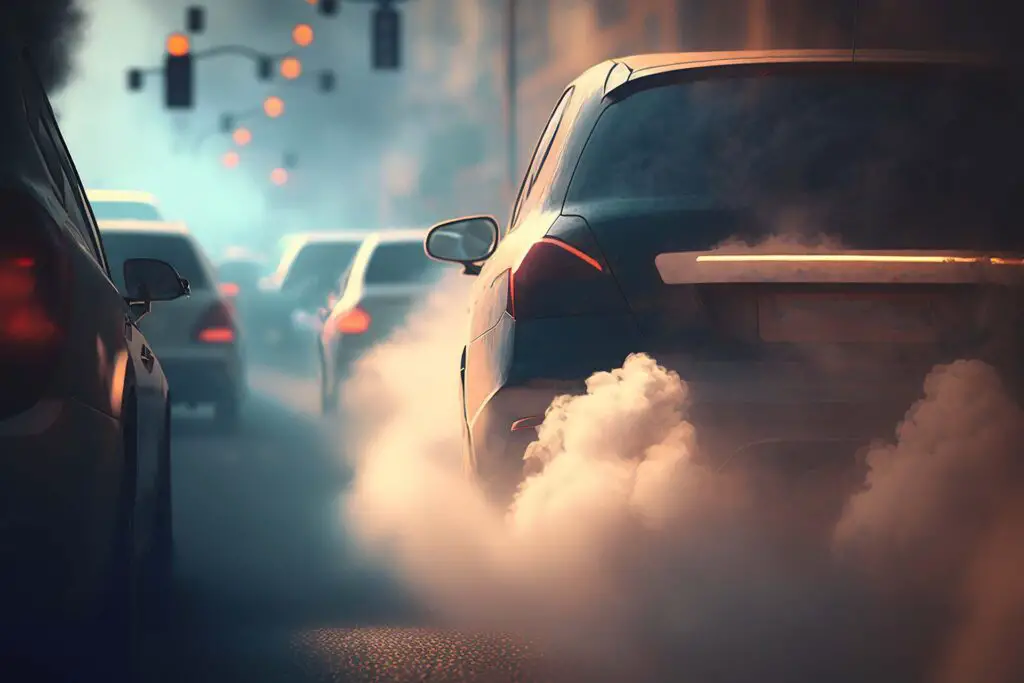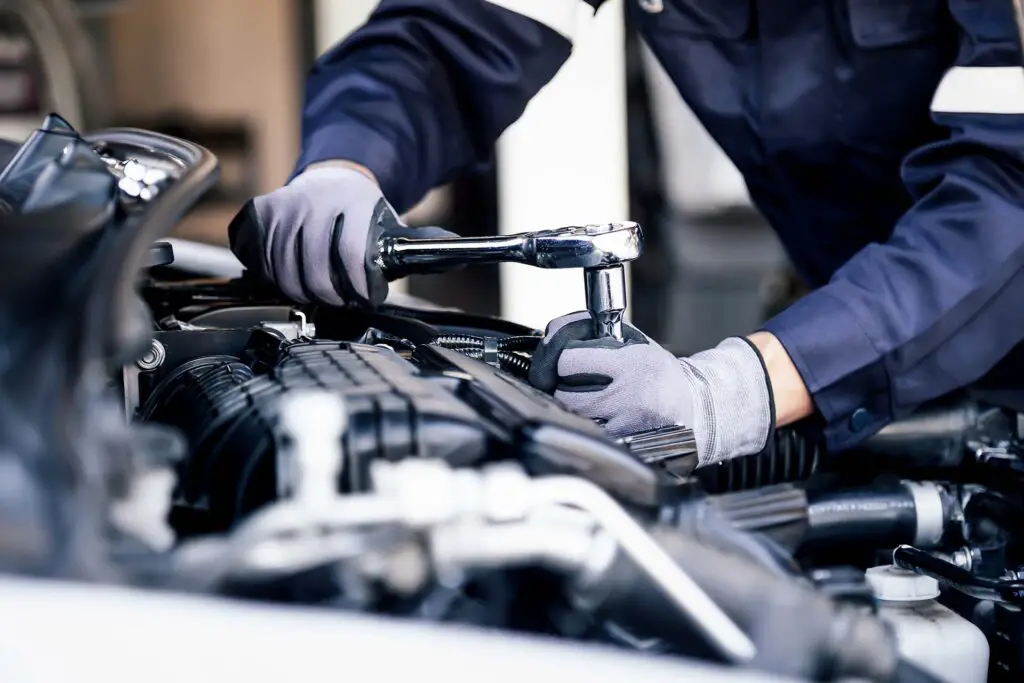Do you ever look in your rearview mirror and see some eerily dark fumes behind you? Before you conclude what might be happening to your beloved four-wheeler. It’s important to know what causes black smoke from car exhaust in the first place. So, let’s explore some common culprits and how they can indicate more serious underlying problems with your vehicle.
When there are dark fumes following you down the road, one thing’s for certain – the fuel is not being burned efficiently. There are various reasons why this might happen, from simple maintenance issues such as a clogged air filter to more serious problems connected to the engine itself.
What Is Black Smoke From Car Exhaust?
Black smoke from a car’s exhaust refers to the dark-colored emissions released from the tailpipe. It’s usually easy to spot. It is typically thick and dark in color and may have a noticeable odor. These fumes are primarily composed of unburned carbon particles and other pollutants that are harmful to the environment and human health.
In addition to being harmful to the environment, black emissions can also be an indicator of a serious problem with the car’s engine. So, it’s crucial to familiarize yourself with the common indicators as well as culprits in order to determine your best course of action.
How It Differs From White and Blue Smoke
Blue smoke from car exhaust is a sign of burning oil in the engine and can result from worn piston rings, valve seals, or other components. On the other hand, white fumes typically indicate the presence of moisture in the combustion chamber, which can be caused by a blown head gasket or a cracked engine block.
Besides indicating different problems with the vehicle, these fumes have different smells accompanying them. White smoke, primarily composed of water vapor, can have a sweet or burning smell. Blue fumes are mostly made of oil particles and have a distinct burning oil smell. In comparison, black emissions can come with various smells, including acrid and burnt, depending on the underlying problem.
What Are the Indicators of Black Smoke
In addition to the thick and dark-colored fumes, here are some common indicators that you’re dealing with black emissions:
- Sooty residue around the tailpipe,
- A noticeable odor of fuel or burning oil,
- Reduced fuel efficiency,
- Decreased engine performance and power,
- Car black smoke from the exhaust when accelerating or at high speeds,
- An illuminated check engine light on the dashboard,
- Rough idling or stalling,
- Hesitation or difficulty starting the engine.
The presence of these dark fumes can also be detected through the use of an emissions testing device, which can measure the exact amount of pollutants being released from the tailpipe. This test is typically required by state or local authorities as part of an effort to reduce air pollution and improve air quality. If the vehicle’s emissions exceed the legal limit, it may be required to undergo repair or modifications to bring it into compliance.

What Are the Causes of Black Smoke From Car Exhaust Pipe?
No matter if you own a brand-new car, a used vehicle, or one with a salvage title, if you’re dealing with your car blowing black smoke from the exhaust, that could mean only one thing – the fuel is not being burned efficiently. However, this can be caused by a variety of factors. Ranging from simple maintenance issues to more serious problems with the engine or fuel system.
Understanding the causes of this phenomenon is essential for diagnosing and repairing any issues with your car’s performance. As well as reducing your carbon footprint and ensuring the safe operation of your vehicle. So, let’s take a look at the most common culprits behind this occurrence:
Air to Fuel Ratio: Too Much Fuel, Not Enough Air
One of the most common causes of dark fumes following you wherever you go is an improper air-to-fuel ratio. Specifically, if the engine is receiving too much fuel and not enough air, it can result in incomplete combustion and the release of unburnt carbon particles.
This can occur for a variety of reasons. Such as a clogged air filter, a faulty fuel injector, or a malfunctioning oxygen sensor. This can lead to decreased fuel efficiency, reduced engine performance, and rough idling or stalling.
Clogged Air Filter: Signs to Look Out For
As mentioned, an improper air-to-fuel ratio can be caused by a clogged air filter, and it has the same results – reduced performance and decreased fuel efficiency. Additionally, you may notice a decrease in acceleration or an increase in engine noise.
So, be sure to have your air filter checked regularly and replaced as needed to prevent it from becoming clogged. Something as simple as that can go a long way in preventing more serious engine problems and consequently cutting down expenses needed for repairs.
Fuel Injectors: Symptoms and Causes of Malfunctioning Injectors
Fuel injectors are responsible for delivering the proper amount of fuel to a vehicle’s engine. When they malfunction, there is an improper air-to-fuel ratio, and that can lead to a range of engine problems.
Contrary to popular belief, putting the wrong gas in your four-wheeler is not the cause of a faulty fuel injector. This happens more commonly when there are underlying electrical problems, as well as leaks or cracks in the injector itself. Additionally, like the air filter, this component can be clogged by dirt or debris, which can significantly affect its efficiency.
Faulty Sensors: How They Affect Fuel Efficiency
Modern vehicles use a variety of sensors to monitor the performance of the engine and fuel system. When one of these sensors malfunctions, it can cause a range of engine problems, including reduced fuel efficiency and dark fumes emitting from the tailpipe.
Most commonly, the culprit is a faulty oxygen sensor, which measures the amount of oxygen in the exhaust and helps to regulate the air-to-fuel ratio. Additionally, it might be the mass airflow sensor, which measures the amount of air entering the engine and adjusts the amount of fuel delivered accordingly. When these sensors fail, the engine may receive too much fuel, resulting in incomplete combustion and the release of unburnt carbon particles.
Turbocharger Issues: How to Identify the Issue
A turbocharger is a device that increases the power output of an engine by compressing the air before it enters the combustion chamber. Its malfunction can cause a range of engine problems, and it’ll lead to decreased performance or acceleration, a whistling or whining noise from the engine, and excess smoke emissions. Additionally, you may notice that the turbocharger takes longer to kick in or that the engine struggles to maintain high speeds.
Engine Problems: Overheating, Worn Out Parts, or Incorrect Timing
As mentioned several times throughout this overview, dark fumes can be caused by a range of engine problems. These can include overheating, worn-out parts, or incorrect timing. Overheating can cause damage to the engine’s pistons, valves, and other components, leading to incomplete combustion and the release of unburnt carbon particles.
Worn-out parts, such as piston rings or valve seals, can allow oil to enter the combustion chamber, leading to the burning of oil and the release of exhaust gasses. On the other hand, incorrect timing can lead to improper combustion and the release of unburnt fuel.
How to Diagnose the Problem
Diagnosing the underlying problem that is causing dark emissions from your four-wheeler’s tailpipe can be a complex process that requires inspection and testing. To get to the bottom of it, you can inspect the vehicle yourself, but it’s best to take it to a professional mechanic if you have any questions or concerns.
What to Do When You See Black Smoke
If you notice a dark cloud following you everywhere you go, from the famous routes in the US to the cities with the worst drivers, the first thing you should do is pull over and turn off the engine to prevent further damage. Next, wait for the engine to cool down, and once it does, it’s time to start looking for visible damage and find the source of the fumes.
How to Identify the Source of the Smoke
Here are the vehicle components you should check, with explanations of what exactly you need to look out for:
| Component | What to Check |
| Engine and Exhaust System | Check for visible signs of damage, leaks, or wear |
| Air and Fuel Filter | Check for blockages or damage |
| Fuel Injectors and Oxygen Sensor | Inspect for malfunctioning or damage |
| Oil Level and Condition | Check for burning oil or oil leaks |
| Spark Plugs and Compression | Conduct a compression test or inspect spark plugs for wear or damage |
When to Call a Mechanic
While it’s commendable to try and do things on your own, it’s best to seek out professional opinion and have a qualified mechanic inspect your four-wheeler. They have the knowledge needed for correctly diagnosing the cause of the fumes, and the tools required for repairing or replacing any damaged parts.

How to Fix the Issue
There are car problems that can be solved with basic DIY skills, but there are also major issues that require the expertise of a professional mechanic. For example, getting gas out of the vehicle or replacing malfunctioning spark plugs are basic maintenance tasks that most car owners can handle themselves.
However, problems with the engine, fuel system, or other critical vehicle components require specialized skills and equipment only a qualified mechanic can provide.
DIY Fixes for Minor Issues
If you know the exact cause of the problem, here are a few things you can do by yourself:
- Change the air filter if it’s dirty or clogged,
- Use a fuel system cleaner to remove any buildup in the fuel injectors or lines,
- Replace the fuel filter if it’s dirty or clogged,
- Check the spark plugs for wear or damage and replace them if necessary,
- Inspect the PCV valve and replace it if it’s malfunctioning,
- Check for any vacuum leaks and repair if necessary,
- Use high-quality engine oil and keep the oil level at recommended levels.
Professional Repairs for Major Problems
Serious issues with the engine, transmission, or fuel system definitely require professional help. These complex components require specialized knowledge, tools, and equipment that only qualified mechanics possess. They also use high-quality replacement parts and follow manufacturer-recommended procedures to ensure the safety and reliability of your vehicle.

Learn Everything About Black Smoke From Car Exhaust and Enjoy Your Ride
All in all, dark smoke emitting from your tailpipe is something you want to address quickly and seriously. There can be a variety of causes behind it, and figuring out the root of the issue might require the expertise of a professional mechanic.
If you’re noticing a dark cloud following you around, don’t hesitate to get to the bottom of it sooner rather than later so you keep yourself and others safe on the road. By staying mindful of your car’s health, you can keep it running in top condition for years to come!








